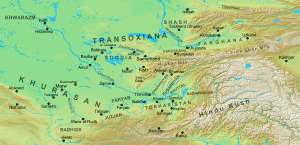| Shams al-Mulk Nasr | |
|---|---|
| Ruler of Transoxiana | |
| Reign | 1068 – 1080 |
| Successor | Khizr Khan |
| Died | 1080 Transoxiana |
| Consort | Aysha Khatun |
| Dynasty | Karakhanid dynasty |
| Father | Ibrahim Tamgach khan |
| Religion | Sunni Islam |
Shams al-Mulk Nasr was a Karakhanid ruler in Transoxiana from 1068 to 1080. He was one of the greatest rulers of the dynasty.
Biography

He was the son of Böritigin, a Karakhanid ruler from the western branch of the family, known as the "Alids", which was named after their ancestor Ali ibn Musa Qara Khan.

Shams al-mulk is known for its buildings in the Zerafshan valley. Shams al-mulk built the palace and gardens of Shamsabad in Bukhara, where the Karakhanids later lived. The palace was located southwest of the Magok-i-Attari Mosque, outside the Bukhara. Shams al-Mulk was the first ruler of the city to build a royal residence outside the rabad of the city, on the site of the current Namazgah.
One of the most important Karakhanid structures, most of which survived at the beginning of the 20th century, is Rabati Malik. It is located in Navoi, 110 km northeast of Bukhara on the road to Samarkand. The complex was greatly expanded in 1078–1079 by Shams al-Mulk.
During the reign of Shams al- mulk, Omar Khayyam was invited to Samarkand.
Shams al-Mulk died in 1080 and was succeeded by his brother Khizr-khan.
References
- McClary, Richard Piran. Medieval Monuments of Central Asia: Qarakhanid Architecture of the 11th and 12th Centuries. Edinburgh University Press, 2020, p.109
- McClary, Richard Piran. Medieval Monuments of Central Asia: Qarakhanid Architecture of the 11th and 12th Centuries. Edinburgh University Press, 2020, p. 272
- McClary, Richard Piran. Medieval Monuments of Central Asia: Qarakhanid Architecture of the 11th and 12th Centuries. Edinburgh University Press, 2020, p.202
- Boris A. Rosenfeld «Umar al-Khayyam» in Helaine Selin, Encyclopaedia of the History of Science, Technology, and Medicine in Non-Western Cultures, Springer-Verlag, 2008, , p.215-216
- Bosworth 1968, p. 65.
Sources
- Bosworth, C. E. (1975). "The early Ghaznavids". In Frye, R. N. (ed.). The Cambridge History of Iran, Volume 4: From the Arab Invasion to the Saljuqs. Cambridge: Cambridge University Press. pp. 162–198. ISBN 0-521-20093-8.
- Davidovich, E. A. (1996). "The Karakhanids". History of Civilizations of Central Asia, Volume III: The Crossroads of Civilizations: A.D. 250 to 750. Paris: UNESCO. pp. 119–145. ISBN 92-3-103211-9.
- Bosworth, C. E. (1968). "The Political and Dynastic History of the Iranian World (A.D. 1000–1217)". In Frye, R. N. (ed.). The Cambridge History of Iran, Volume 5: The Saljuq and Mongol periods. Cambridge: Cambridge University Press. pp. 1–202. ISBN 0-521-06936-X.
- Kochnev B.D. Numizmaticheskaya istoriya Karakhanidskogo kaganata (991—1209 gg.). Moskva «Sofiya», 2006.
- McClary, Richard Piran. Medieval Monuments of Central Asia: Qarakhanid Architecture of the 11th and 12th Centuries. Edinburgh University Press, 2020.
Further reading
- Bosworth, C. E. (1985). "ʿALĪTIGIN". Encyclopaedia Iranica, Vol. I, Fasc. 8. London et al. pp. 887–888.
{{cite encyclopedia}}: CS1 maint: location missing publisher (link)